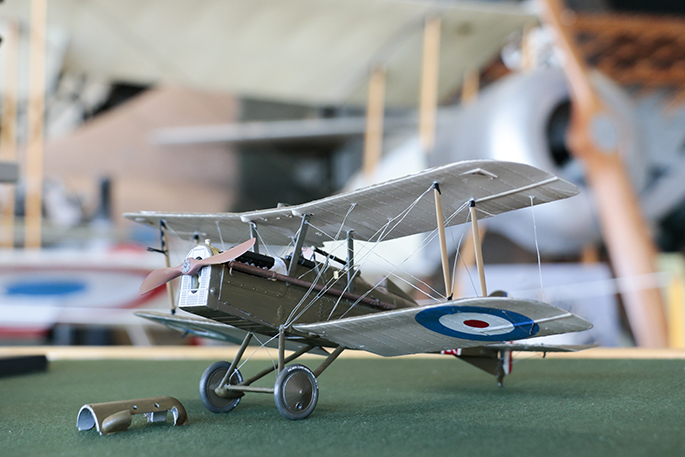It sits in a glass show case in the corner of the shop at Classic Flyers. It's treasured.
It's a quarter scale model of the 200hp, 149kw, Wolseley Viper piston engine – the variant that powered what was arguably the best British built fighter plane of World War One, the S.E.5 or Scout Experimental 5.
'It was very fine to be in a machine faster than the Huns” said legendary British flying ace Albert Ball. He made 11 of his 44 kills flying an S.E.5. 'And it was also fine to know one could run away just as things got too hot.”
That was 100 years ago and today Bill Janes has managed to peel back the power unit of the S.E.5 to a quarter scale model in his Greerton workshop.
'Yes, yes. Of course it runs” says Bill Janes, modeler and restorer, who spent nine months building the engine. 'But it's a bit oily and my neighbour's white fence got spattered with oil drops.” He then gave the piece of precision aeronautical engineering to Classic Flyers because it deserved to be there. And 12 other model aero engines he built. 'Virtually a history of the progress of the aero engine right from the 1909 pioneer aircraft right up until the modern Cessna.”
And here's where Sir Peter Jackson comes into play – in a round about way. To give the Wolseley Viper some context, the museum decided they needed a model of the S.E.5. They're hardly thick on the ground.
'But I said to the museum if you find one, a kitset, then I will build it for you” says six-year Classic Flyers volunteer and modeler Geoff Tansley. And it just so happened that before ‘Lord of the Rings', ‘Heavenly Creatures' and ‘The Frighteners', Sir Peter also messed around with scale modelling, high quality scale models of World War One aircraft.
So he set up a company called Wingnut Wings to share accurate, highly detailed, large scale models. 'And he just happened to have an S.E.5. Beautiful” purrs Geoff. 'I have made a lot of kit sets over the years and that's one of the best. The detail is exquisite.”
And no sanding, no drilling holes, no cursing because that doesn't fit here or there.
It took Geoff 50 hours to make the model. ”It's not a case of breaking open a box and gluing A to B and slapping some paint on it. It was an absolute joy, I would love another one.”
The ‘absolute joy' is now parked up in the glass show case alongside Bill Jane's ¼ scale of the 200hp, 149kw, Wolseley Viper piston engine in the shop at Classic Flyers. One down and 12 to go Geoff.
The engine is an extraordinary piece of master craftsmanship. Bill Janes made everything except the valve springs. Even made the spark plugs. And they probably could have done with that expertise when the S.E.5 was being developed. The first two prototypes were lost in crashes – the first killing the chief test pilot at the Royal Aircraft factory.
First Viscount Hugh Trenchard, Marshal of the Royal Air Force at the time and the man considered the father of the RAF was told of the S.E.5 – 'What a bloody awful aeroplane this is.” But that pilot got to like it. Even became a flying ace in one.
The S.E.5 was inherently stable making it an excellent gunnery platform but it was also very manoeuvrable and one of the fastest aircraft of the war at 222km/h. And while not as agile or effective in a dogfight as the more famous Sopwith Camel it was much easier and safer to fly.
It wasn't pretty –square and boxy. But pilots could forgive that because the S.E.5 had 'good crashworthiness and survivability, and was relatively resistant to battle-damage.
So it's not just the model, it's the story behind the model.



0 comments
Leave a Comment
You must be logged in to make a comment.